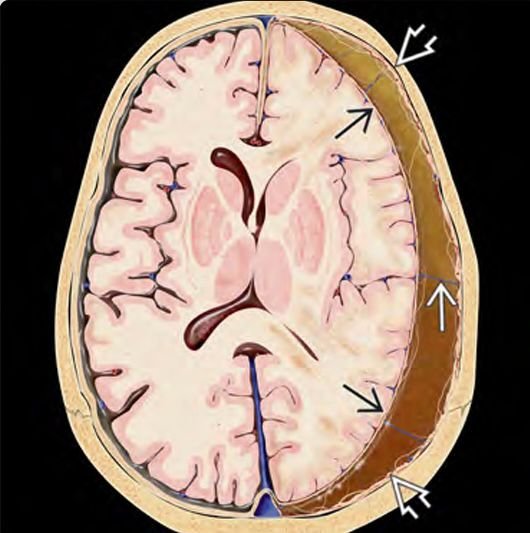Extradural Hematoma
Extradural Hematoma
A Pediatric Extradural Hematoma (EDH), also known as epidural hematoma, is a life-threatening form of traumatic brain injury where blood collects between the inner surface of the skull and the outer covering of the brain (dura mater). Although relatively uncommon in children compared to adults, when it occurs, rapid diagnosis and emergency neurosurgical intervention are critical to saving the child’s life. In Bangladesh, EDH in children often results from falls from rooftops, motorbike or rickshaw accidents, or physical abuse, and it is often underdiagnosed due to delayed hospital visits or lack of specialized pediatric neurosurgical care in rural areas. Dr. Md. Nafaur Rahman, one of the most respected pediatric neurosurgeons in Bangladesh, offers advanced, evidence-based care for EDH through timely diagnosis, emergency surgery, and postoperative rehabilitation at National Institute of Neurosciences & Hospital (NINS) and Bangladesh Paediatric Neurocare Centre. What Is an Extradural Hematoma? An Extradural Hematoma (EDH) refers to the accumulation of blood between the skull and the dura mater, typically resulting from the rupture of arteries—most commonly the middle meningeal artery—due to a skull fracture following trauma. This hematoma compresses the brain, leading to rapidly worsening neurological function and, if not treated promptly, coma or death. In pediatric patients, early symptoms may be subtle but can escalate quickly. Causes of Pediatric EDH in Bangladesh Fall from rooftops or trees Head injury from road traffic accidents (rickshaw, CNG, motorbike) Assaults or child abuse (non-accidental trauma) Heavy object falling on the head Birth trauma (in neonates) Sports-related head injuries Signs and Symptoms of Extradural Hematoma A classic symptom pattern includes a "lucid interval"—the child loses consciousness after injury, regains it temporarily, then deteriorates rapidly. Early Symptoms: Vomiting Headache Temporary confusion Drowsiness Pupillary changes (one dilated pupil) Worsening Signs: Seizures Hemiparesis (weakness on one side) Lethargy progressing to coma Fixed and dilated pupil on the side of injury Respiratory changes Signs of increased intracranial pressure (bulging fontanelle in infants) In Bangladesh, where home remedies or local treatments are often tried first, many children with EDH present late, which increases risk of permanent damage. Diagnosis of EDH Emergency diagnosis is critical. Dr. Md. Nafaur Rahman ensures rapid assessment through: Urgent CT Scan of the Brain: Reveals the classic biconvex (lens-shaped) hyperdensity indicating EDH Skull X-ray (if CT not available): May show fracture Neurological Examination: Pediatric Glasgow Coma Scale (GCS) scoring Monitoring of vital signs and consciousness level Emergency Management and Surgical Treatment by Dr. Md. Nafaur Rahman 1. Initial Stabilization Securing airway, breathing, and circulation (ABCs) Oxygen and IV fluids Monitoring intracranial pressure Anticonvulsants if seizures present 2. Surgical Intervention Surgery is the mainstay of treatment in most moderate-to-severe EDH cases. Emergency Craniotomy or Burr Hole Evacuation ➤ The blood clot is removed to relieve pressure on the brain. ➤ Bleeding vessels are cauterized or repaired. ➤ The skull is reconstructed and the child is shifted to the ICU. Dr. Nafaur performs minimally invasive procedures where possible, using child-specific equipment to ensure precision and safety. 3. Postoperative Care Pediatric ICU observation Repeat imaging if necessary Pain and seizure management Early neurorehabilitation Counseling for parents on head injury prevention Prognosis of EDH in Children With early surgical intervention, the prognosis of EDH is excellent in children. However, delays can result in: Brain herniation Permanent neurological deficits Cognitive and behavioral problems Speech or motor delays Death In Bangladesh, creating awareness about the golden window period (first few hours after injury) is key to saving lives. Importance of Specialist Care in Bangladesh In rural and semi-urban areas of Bangladesh, EDH often goes unrecognized, or is mismanaged due to lack of CT scan availability and neurosurgical expertise. Dr. Md. Nafaur Rahman provides: Fast-track neurosurgical admission 24/7 emergency surgical care Postoperative ICU and pediatric neuro-rehabilitation Parent education and trauma counseling Affordable treatment plans for low-income families Why Choose Dr. Md. Nafaur Rahman? Assistant Professor, Pediatric Neurosurgery, NINS Chief Consultant, Bangladesh Paediatric Neurocare Centre Over a decade of experience in pediatric head trauma and neurosurgery Advanced surgical and ICU facilities Compassionate, family-centered care Contact for Emergency or Appointment 📌 Dr. Md. Nafaur Rahman Assistant Professor, Pediatric Neurosurgery, NINS Chief Consultant, Bangladesh Paediatric Neurocare Centre 📞 For Appointment / Emergency Consultation: 📱 +8801912988182 | +8801607033535 🌐 Visit: www.neurosurgeonnafaur.com
YouTube Videos and Patient Reviews on Extradural Hematoma










